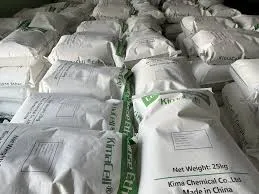
dec . 26, 2024 03:17 Back to list
HPMC Applications in Detergents and Its Impact on Cleaning Efficiency and Formulation
The Role of HPMC in Detergent Formulation
Hydroxypropyl Methylcellulose (HPMC) has gained significant attention in various industries, including the formulation of detergents. This versatile cellulose ether is derived from natural cellulose sources and modified through a series of chemical reactions. Its unique properties make it an essential ingredient in the production of both home and industrial cleaning products. This article explores the uses of HPMC in detergent formulations, emphasizing its functionalities, benefits, and applications.
What is HPMC?
HPMC is a non-ionic, water-soluble polymer known for its thickening, binding, and film-forming properties. Its chemical structure is modified to provide varying degrees of hydroxypropyl and methyl substitution, which influences its solubility and viscosity. The versatility of HPMC allows it to perform a multitude of roles in detergent formulations, catering to the specific needs of manufacturers.
Functionality in Detergents
1. Thickening Agent One of the primary uses of HPMC in detergents is as a thickening agent. By increasing the viscosity of liquid detergents, HPMC helps to improve the product's stability and enhances the sensory experience for users. A thicker detergent not only looks more appealing but also allows for better control when dispensing, reducing waste and improving user satisfaction.
2. Stabilizing Agent HPMC acts as a stabilizer in detergent formulations, preventing the separation of components and maintaining homogeneity. This is particularly important in products that contain suspended abrasive agents or multiple active ingredients, ensuring that the product remains effective over its shelf life.
3. Film-Forming Agent The film-forming properties of HPMC allow it to create a protective layer on surfaces during cleaning. This layer can help capture dirt and grime, making it easier to rinse away while also providing a smoother feel to the cleaned surfaces. This characteristic is particularly valuable in fabric softeners, where HPMC enhances the feel of fabrics post-washing.
4. Dispersant In powdered detergents, HPMC functions as a dispersant, helping to evenly distribute solid active ingredients throughout the formulation. This ensures that cleaning agents are uniformly available, resulting in consistent cleaning performance with each wash.
5. Compatibility HPMC is compatible with a wide range of surfactants and other ingredients commonly found in detergent formulations. This compatibility allows formulators to create customized products that meet specific cleaning needs while maintaining stability and efficacy over time.
hpmc uses in detergent

Benefits of Using HPMC in Detergents
The incorporation of HPMC into detergent formulations presents numerous advantages.
- Eco-Friendly Option As a natural derivative, HPMC is biodegradable and considered more environmentally friendly compared to synthetic alternatives. Consumers are increasingly seeking sustainable products, and HPMC's profile aligns well with this demand.
- Improved Performance The unique properties of HPMC not only enhance the performance of detergents but also contribute to their overall quality. This can translate into higher consumer satisfaction and brand loyalty, essential factors in a competitive market.
- Versatility With varying degrees of substitution, HPMC offers formulators the flexibility to tailor their products for specific applications. Whether for laundry detergents, surface cleaners, or dishwashing liquids, HPMC can fulfill diverse roles.
Applications of HPMC in the Detergent Industry
HPMC finds applications across a wide range of detergent types. In laundry detergents, its thickening and stabilizing properties enhance the performance of liquids and gels. In household cleaners, HPMC’s film-forming abilities allow for improved surface adherence, making it easier to tackle tough stains. In dishwashing products, it acts as a dispersant and thickener, ensuring that all components work cohesively for maximum cleaning efficiency.
Conclusion
In conclusion, Hydroxypropyl Methylcellulose (HPMC) plays a vital role in the detergent industry, offering functionalities that enhance product performance, stability, and user experience. As consumer demand continues to shift towards eco-friendly and efficient cleaning products, the importance of HPMC will likely grow. Its versatility and effectiveness make it an invaluable ingredient in the formulation of modern detergents, catering to the evolving needs of both manufacturers and consumers alike.
-
Unlocking the Benefits of HPMC Products: A Gateway to Versatile Applications
NewsAug.07,2025
-
Unleashing the Potential of HPMC Ashland: A Comprehensive Look
NewsAug.07,2025
-
Tile Bonding Cellulose: The Key to Superior Adhesion and Durability
NewsAug.07,2025
-
Hydroxypropyl Methylcellulose Powder: The Versatile Component in Modern Pharmaceuticals
NewsAug.07,2025
-
Hydroxyethyl Cellulose: The Versatile Solution for Various Industries
NewsAug.07,2025
-
Hydroxyethyl Cellulose (HEC): The Versatile Polymer for Various Applications
NewsAug.07,2025







